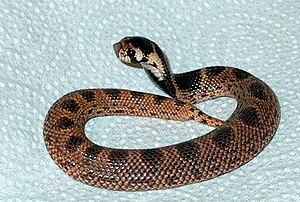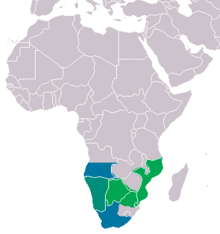Shield-nosed cobra
| Shield-nosed cobra | ||||||||||||
|---|---|---|---|---|---|---|---|---|---|---|---|---|

Shield-nosed cobra ( Aspidelaps scutatus ) |
||||||||||||
| Systematics | ||||||||||||
|
||||||||||||
| Scientific name | ||||||||||||
| Aspidelaps scutatus | ||||||||||||
| Smith , 1849 |

The shield nose Cobra ( Aspidelaps scutatus , also shield cobra or shield coil ) is a snake of the genus of aspidelaps ( Aspidelaps ) from the family of Venomari (Elapidae). It occurs in three or four subspecies in southern Africa.
features
Shield-nosed cobras are small snakes whose compact bodies reach a length of 40 to 60 centimeters. The head is very short and hardly separates from the neck. It is named after the conspicuously wide snout shield that covers the tip of the snout and ends at the top of the head at eye level to form an obtuse triangle. The sides of the head taper off in a bright corner, the nape and throat are black. The lower jaw and throat region are whitish. The body color varies from gray to brown to reddish with brown to almost black saddle spots or irregular transverse bands. The ventral side is yellowish to gray-white. The trunk has 21, rarely 23 rows of smooth or weakly keeled scales in the middle, in males 25 to 30 and in females 20 to 24 subcaudal shields and an undivided anal shield .
The subspecies A. s. fulafula ( Bianconi 1849) is up to 75 centimeters longer than the nominate form .
The subspecies A. s. bachrani Mertens 1954 has a monochrome black head, neck and neck, but is no longer regarded by most authors as a valid subspecies, but only as a color variety.
Occurrence
The species prefers stony or sandy semi-deserts . The nominate form ( A. s. Scutatus ) occurs in Namibia , Botswana , western Zimbabwe and northern South Africa , A. s. intermediatus Broadley, 1968 in northeastern South Africa and A. s. fulafula in southern Mozambique and Zimbabwe.
Way of life
Shield-nosed cobras spend the day buried in the ground or in rodent burrows and hunt small amphibians, reptiles and mammals at night. When threatened, they straighten up, inflate the body and flatten the neck like a cobra . The animals also play dead less often. Bites are usually not life-threatening for humans due to the small amount of poison given off. In addition, they are usually hit with the mouth closed.
The species reproduces through eggs.
swell
- Ludwig Trutnau: poisonous snakes . Eugen Ulmer, Stuttgart 1998, ISBN 3-8001-7371-9 , pp. 56-58 .